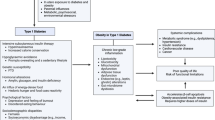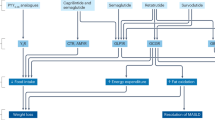Abstract
Obesity is an important risk factor for the development of type 2 diabetes. The increasing incidence of obesity accounts in large part for the emergence of type 2 diabetes. Drug treatment of hyperglycaemia and hypertension lowers the risk of diabetic complications, but many of these treatments, including sulphonylureas, insulin and beta-blockers, are associated with weight gain. There is increasing evidence that obesity may be an independent risk factor for complications in both type 2 and type 1 diabetes. Therapies to lower body weight will undoubtedly have a role in the treatment of diabetes to potentially avert weight gain associated with anti-diabetic therapies, to lower glycaemia, and possibly even to lower the risk of diabetic complications. However, many questions remain to be answered.
This is a preview of subscription content, access via your institution
Access options
Subscribe to this journal
Receive 12 print issues and online access
$259.00 per year
only $21.58 per issue
Buy this article
- Purchase on Springer Link
- Instant access to full article PDF
Prices may be subject to local taxes which are calculated during checkout
Similar content being viewed by others
Author information
Authors and Affiliations
Corresponding author
Rights and permissions
About this article
Cite this article
Adler, A. Obesity and target organ damage: diabetes. Int J Obes 26 (Suppl 4), S11–S14 (2002). https://doi.org/10.1038/sj.ijo.0802212
Published:
Issue Date:
DOI: https://doi.org/10.1038/sj.ijo.0802212
Keywords
This article is cited by
-
Chronic NF-κB blockade improves renal angiotensin II type 1 receptor functions and reduces blood pressure in Zucker diabetic rats
Cardiovascular Diabetology (2015)
-
Effect of dietary resveratrol on the metabolic profile of nutrients in obese OLETF rats
Lipids in Health and Disease (2013)
-
Population-level effects of the national diabetes prevention programme (FIN-D2D) on the body weight, the waist circumference, and the prevalence of obesity
BMC Public Health (2011)
-
Obesity and Persistent Organic Pollutants: Possible Obesogenic Effect of Organochlorine Pesticides and Polychlorinated Biphenyls
Obesity (2011)
-
What have rare genetic syndromes taught us about the pathophysiology of the common forms of obesity?
Current Diabetes Reports (2004)



